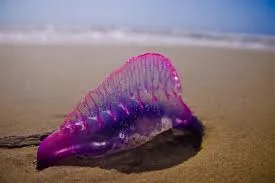
Plankton is called the whole set of small organisms, devoid of active organs of movement and, as it were, floating in the water. They move along with the water masses.
Plankton includes both plant organisms (phytoplankton) and animals (zooplankton). In marine phytoplankton, a particularly prominent place is occupied by unicellular algae - diatoms, peridinium, blue-green, flagellates, and in zooplankton - foraminifers and radiolarians from unicellular, and from multicellular - intestinal cavities (jellyfish, kmenophores, siphonophores), some groups of worms and tunicates, crustaceans and various larvae of invertebrates and fish. In addition, several more biological groups are distinguished among the population of the sea - pleuston, neuston, hyponeuston
A pleuston is a group of organisms that float wholly or partly on the surface of the water, using a surface tension film as a support.
(Velella)
The neuston is the inhabitants of the surface film, and the hyponeuston is the collection of organisms that accumulate under the surface tension film in the top few centimeters of water.